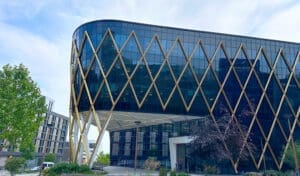How to get the Most Value from your Life Science Biotech Conference Attendance
Make the most of exhibitions and conferences as a Life Science small company
Conferences are a vital opportunity to get your company, products or services and people in front of potential new customers. It’s where technical audience’s life sciences, biotech and industrial sectors gather to share the latest trends and solutions. To find out what’s out there and take it back to their departments and business to keep them competitive.
The pressure to deliver results
The pressure is on you to create impact and awareness of your business to that audience over just a few days. And for the people on the ground, the expectation is that you come back with high quality leads to deliver sales that fulfil the end of year targets that are on the near horizon.
The challenge as a Life Science SME with a limited budget is that you’re competing with “platinum” sponsors, big flashy stands and the eye-catching hospitality they organise.
You often have the added challenge of company exhibition halls separate from packed lecture theatres with limited breaks.
You’re competing for the attention of delegates on a tight schedule with their own agenda to get the most from their attendance in terms of presentations, workshops and personal learning.
So let’s break this down into a “why? where? who? and how?” for addressing those issues as a Life Science company.
Why?
The investment is high with booth’s costing thousands to secure, often in locations that require significant travel time and accommodation stays. That’s on top of the giveaways, delegate passes, entertainment and time out of the office for key people.
So the other questions of where who and how are led by the why are you going. And answering why you’re going is key to managing expectations of what you should expect to get from attending.
Asking why you’re going refines what collateral you want to produce and who to target with your online marketing before and during the event. Consider realistically how quickly any leads you might get will impact sales.
Do you need to focus as much on post-event activity as you do in attending to see results on the bottom line? Make it clear to the whole company the objective of why you’re going to this Life Science conference.
For example.
- Raise awareness that you are a life science business with solutions for that industry.
- Maintain your presence in a segment that you are already known in.
- Launch or market test a new life science product for this market.
- Generate new leads focussed for an existing product or product line.
- Meet key life science clients to close sales.
And be realistic about lead generation and the attention you can expect. Is this your first time at the event or is it your third year running and last year was a big success? Having a clear objective makes the success you want more likely and manageable.
As part of this consider the size of the conference audience and most importantly the make-up of the audience. It may have 2,000 delegates but if you can segment that in some way you can be more realistic in terms of expected lead generation potential. Conference organisers should be able to give you help to do this as a condition of investing in the event.
If you’re not sure about significantly investing in a conference for the first time, then consider going as a delegate only to start with. Then book for next year at the event, where you can talk to the organisers directly, and plan for the results you want next year based on what you’ve learnt.
An excellent way to create a touch-point with a purpose other than emailing general information is to contact potential customers with a personal message and ask if they’re going. Ask why not if they aren’t. If they are going, what are their priorities? Start the conversation as early as possible, and you’ll know what the key drivers are for people going to the event that you want to connect.
Setting these expectations will focus you on why you are going and can you offer them anything relevant at the event. Or make the call that this isn’t a good event and you can invest that money differently.

Where?
The where in this case is where you stay. Consider the relative cost of having a large, well-positioned booth space in a crowded hall competing with all those other booths in a limited time-frame to the cost per night in the conference hotel.
Especially at conferences where exhibition hours are limited, or the exhibitors are kept separate from the main presentations. Being in the main conference hotel can overcome limited exposure in a 3m2 x 3m2 booth situated away from the refreshment stations. You need somewhere to stay after all so making it the main conference hotel has several advantages.
- You’re going to get more contact time with delegates in the place where they’re concentrated. It’s the reverse of the exhibition hall where competitors are concentrated in a room that delegates have to go and seek out.
- Networking and communication with key customers and potential customers can occur in a more relaxed, spontaneous way. And it can support formal meetings you make at your booth. Conversations started at the booth can be continued over drinks or even breakfast. If a customer has had a problem or a lead asks a question that needs follow up, you don’t need to rely on them coming back to the booth. You’ll see them where you’re staying to follow up and keep relationship building.
- Less time and energy travelling to and from the conference venue from lower cost accommodation further away. That time and energy you save commuting at the start and end of the day can be invested to make the most of any interactions you make during the day.
When you’re at a conference, it’s about making the most of the exposure you get to customers and potential customers. It’s hard to get appointments to see them at their place of work when they’re busy with the demands of the day-to-day day job. It’s easier to get to have those all-important conversations face to face when you’re in the same space over the four days without shop-floor distractions.

Who?
Conferences are about presenting the latest trends, breakthroughs, data and industry challenges to audiences that could benefit from using your products. Many include poster sessions where post-graduate and competitor companies showcase early research data.
It’s a low-pressure commercial environment where the people responsible for developing your technical products and services can see real-world applications in an educational situation.
They can see first-hand competition performance, emerging problems that the next generation of development should solve and enjoy seeing the results being achieved in the field by the things they’d researched and developed.
Technical people are a valuable asset at conferences. If you can spare them to attend to promote they’ll be there in pre-conference marketing. Being in the vicinity of a scientifically minded audience allows conversations between your technical experts and the people they develop for.
It reinforces the level of your company expertise and support available for potential customers. Let conference attendees know that you’re not just showcasing your latest products, like the platinum sponsors, but giving access to who is building that product and future iterations.
So consider the mix of people you send. Ideally, your representatives should include sales, marketing and research/development.
Another role in considering promoting to customers at a conference is your technical support personnel. Putting a face to an email name or phone voice is an excellent way of establishing a connection with your company.
And consider promoting clinics at your booth with your tech support on your website and pre-conference marketing. Start a conversation with potential customers that isn’t just a sales pitch.
How?
How you present your business at the event falls out of answering the “why? where? and who?” questions. The tactics you deploy come from a clear objective of what you’re going for, who is going, and where the opportunities are going to be for interacting with people during the event.
For example, you may not have anything new to launch, but you want to generate prospects for the existing product or service. And selling opportunities for support and upgrades to existing customers.
So focus on promoting who uses it already, especially local to the conference country or city. Highlight the presentations and posters on the conference agenda by existing customers.
Set a schedule of demonstrations you’ll run from your booth and say you’ll be available in the hotel for demonstrations too. Encourage people to bring their challenges to your technical people at the event. Offer customers out of support who are attending a chance to get a free one-off clinic and show them the value of having that support.
As you gather information on what you’re offering, who will be there. Where you will be available drip-feed this information in as a personal way as possible to a segmented list of prospects, the easiest way to keep this information flowing is via a landing page that you can add to your website.
With sign-up forms or “add to calendar” links. You may not get replies to the communications, but the result will be that when you introduce yourself, they can recall something that they remember about you.
Don’t forget that no plan survives the first contact on the ground so build in time at the end or start of each day for the team to reflect what worked, what didn’t, who you’d like to speak to again. Any FAQs that you can all learn.
Ideally, involve everyone in the business with a voice or video call to share success or feedback real-time issues and come back with solutions.
For example, demonstrating your product at your booth may have revealed a technical problem. Letting people back in HQ know, they can work on a solution, and you make the customer know immediately or supported by an email from your office.
Feedback on product demonstrations shows potential customers how responsive, joined-up and proactive you are as a company to deal with — creating an impact beyond leaving them with a brochure of features and benefits and getting a name and card.
The Takeaway.
Conferences are a significant investment of time and resources for the potential of actual face-to-face interactions with people — potential customers who have already qualified themselves a needing your business solutions by paying to be a delegate.
So when you’re at a conference, it’s about making the most of the exposure you get to customers and potential customers — and ideally connecting them both. Your satisfied existing customers can be your best salespeople on the ground facilitated by you.
There may be a high concentration of potential customers, but there is also high competition for their attention in a busy schedule of events, surrounded by competitor activity.
Competing with all this on the ground is hard if you don’t have the biggest stand or the main hospitality suite.
Communications
So do what you can to target communications to the people who you want to know about you BEFORE the event. Aim to get personal appointments set-up rather than rely on passing booth traffic. These are easier to set-up, and with technical people in support, if you are staying in the main conference hotel with all the delegates.
You will be competing with pre-conference marketing by big companies too. So make your communications are as segmented and personal as possible. Be as a specific as possible about who they can meet such as a technical support person not just sales, times you’re available and what you can show them that’s relevant to their specialism, e.g. research in a certain type of bacteria.
Conference Landing Page
Look at creating a landing page that brings together all of the different aspects you can talk about. Or maybe now is the time to add new content in relevant areas on your website for existing products that you can send to people ahead of the meeting and create a chance to meet and discuss this further.
Get your project started
We’re here to help with the HOW to stand-out and engage successfully with the people you want to speak to on the ground at your next conference. Let's talk. Why not contact us to discuss your project or book one of our 15-minute consultancy sessions so we can help you take action now.

Belinda White | Creative Director
Related Articles
From Spin-outs to the Future of Life Sciences. Insight from BioFocus 2025
Early in June 2025, we had the pleasure of attending the BioFocus 2025 conference at the Catalyst building, nestled in the heart of the Helix Science Park in Newcastle upon Tyne. Hosted by Bionow, this annual event brought together life sciences professionals, innovators, and advocates from across the North of England—and what a day it was.
Read Article >>How Digital Marketing for Life Sciences Delivers Greater Impact Than In-Person Events
Conferences remain vital for networking and learning in the life sciences, healthcare, and biotech sectors. However, their financial, logistical, and environmental drawbacks are increasingly apparent. Especially as budgets and investments are ever more challenging.
Read Article >>Unlock the Secret to Impactful Biotech Presentations with PowerPoint
When creating impactful presentations, it is imperative to understand that there is an art to working in PowerPoint. It requires someone who understands the fundamentals of good design and how PowerPoint works (and its design restrictions).
Read Article >>What Delivers Greater ROI than a Life Science Conference?
In early 2020, marketing departments were finalising the details of their plan for a busy year ahead, including their conferences and workshops.
And then the COVID-19 pandemic hit. Life science businesses began to re-evaluate what 2020 would look like as in-person events were cancelled, and their marketing teams looked for new ways to reach their customers.



